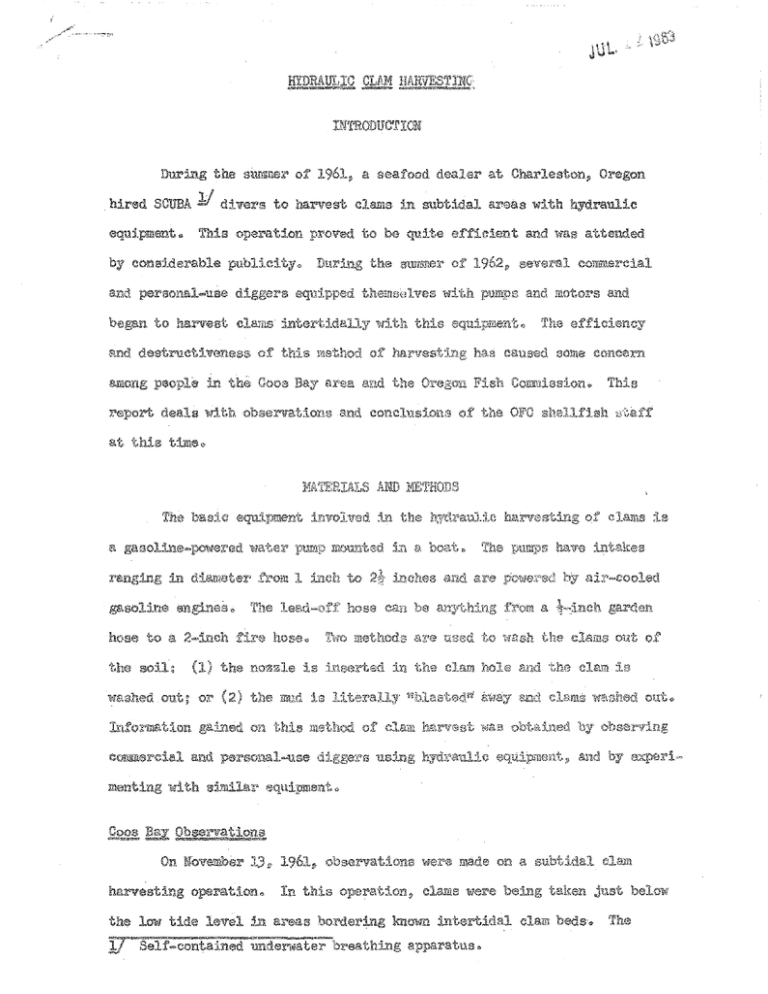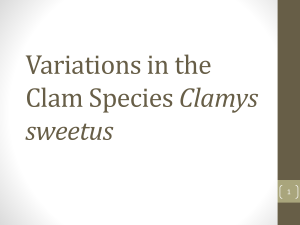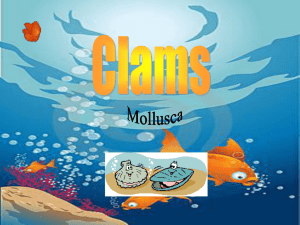11 " hydraulic considerable
advertisement

" \' JUL..' L'IlTRODUC'fICfll During the hired SOUBA SllrnlOO:<' 11 dbrer" of 1961. II seafood dealer at Charleston, Oragon to J;,arvest clams in subtidal area", with hydraulic by considerable pUblicity. t,nemselves pumps and motors and of This and to to a out~ is on and the low tide le',,,,1 in area", bordering known intertidal clam beds. IT Self-contained ~ter breathing apparatuso The of harvest was conducted from a 22.cfoot boat equipped with an air compressor. for the diverts air~line, and a 2-inch gasoline powered pump nozzled down to One diver found and "staked" clam holes and the other diver pro~ 3/4 inch. ceeded to wash out the clams previously located. The two divers ware taking about 100 pounds of clams per hour at that time. Many small cla\ll.s were inci- dentally washed out. On August 15. 1962, a personal~use clam harvester was obser'lfed in Coos Bay using hydraulic equipment to harvest clams. inch pump powered ..lith a 2~ h.p. gasoline mot;or. This man was using a 311.- While lL"lder observation. he harvilsted 20 large gaper clams and 19 small gaper clams ranging in size from 1 to Ii inches in lengUI. L'1formed ~i;,hat These clams ,1/ere left, exposed. i'lhen thhl man 'Was he was ilxceedL'lg the bag limit. he :i.nformed the observers that he was ha:rn.resting the excess for friends. ~riment.!!1 .Qllil.eI'1J''!.ti,~ On May 22. 1963, shellfish pI~jeot pereolL~el. equipped with a l~-inch pump and motor. e.xpetimentIt11l;y dug gaper clams in Yaquina Bay. technique employed reduced the main-line from a ~-inch garden hose attached. in 2~inch The outlet to 1 inch with a This equiilment permitted removal of gaper clams seconds from a depth of 12-18 inches. The effect upon the bottom from the equipment was to leave a 24-30 inch circle washings 1.'1 the area where the clam was removed end a hole 6 inches in diameter ~~d 12-18 inches • Sand clams. bent-nose clams. and one rasorclam were exposed for possible predation by this method. Though not many people utilize the firs'~ two species they are edible and it ie not deemed desirable to destroy them needlessly. The second technique employee! involved the rlilllloval of the reducer and the !-inch garden Ilose. Tha 2-incll main-line then was used to wash out clams. By this method nina square feet of clam bed was washed out cco a depth of 18 inches in l~ minutes. This operation exposed all sizes and speoies of clams, and in general cllused heavy damage to plants and animals alike, Digging clams with a. shovel also displaces smaller cl/l.llls but they are usually covered. hence not exposed to predation. When the is used these pUl11p clams float out and are exposed to predation by gulla. crabs. or starfish. DISCUSSION The ability to take clams with hydraulic equipment has been knowa by the ehellfish staff for several years, and 1..1'1 i'act has been employed clams for marldng stu.dies. '&0 obtain Only within the last ttl/O years has this method of harvMting claJll8 become a serious problem. With the attendant publicity in the Coos Bay area it is expected that the use ot this equipment probably will spread to other estuarie::l. The states of Washington and CalifoI""nia prohibit is quite detriDrental to clam beds sinoe it regrades the bottom Our experiments inrlicate that this equi~nent. basis, is probably no more destro,ctive than a shovel. or other species to predation. In, Coos ~atarisls and when used on a limited HO'>'6ver. large pumps obse:rvations, it was recorded tr~t fellt,are of til:!.;; equipment. and probably the greatest potential danger ·to the displaying slow growth, and if sub,iected to intenlile digging pressure can very readily be reduced in abundance. Accompanying this reduction in ab11l1dance is a reduction in the' «"el'B,g6 size of individual animals han'ested. effect, reduces the potontial yield of the resource. 'Ihill. in 4. The cOllll.lleroia1 clam har4J'est in Coos Bay the period July through December, 1962, amounted to 46,626 pounds compared to 7,406 pounds in 1960, and 13,690 pounds in 1961. Of the 1,6,626 pounds landed in 1962, 46,173 pounds are known to !la'"..e been gaper clams harvested with llydrau,1ic equipnent. tio breakdo'Wu by species is available for the years 1960 and 1961 because f.he clams were reported mostly as "bay clams". Two divers working ,11th SCUBA gear in 1962 were harvesting as llluch as 2,000 pounds of gaper clams per day and averaging 728 pound6 per landing. It can be argued that the divers are haF~esting S resource that is untouched by most clam diggers, but all subt.idal harvest to date is taking place on the outer perimeter of Knorrrl intertidal clam beds. It has always been the opinion of the shellfish staff that these an:'lJllsls seFV"ed as a seed reserve for restocking intert.:'l,dal areas in case of intertidal de<::i.mation. Also, if the subtidal area becomes depleted there is nothing to stop divers from working the intertidal are1l, during high tide. this. No regulations ai; pl~esent Even :If i t were lllegl!,l. policing would be virt;nally imposa:lble. theae a.reas were to be han'ested on both law and high prevent If 'lie would soon be without gaper clams. As information on t.hJ.s typs of equipment eprellde more and more commercial diggers will un,doubtedly 6tar'G ueing it. who become discontented with the present Also, porsonal~uee dig£ore lixnite when taking clams ie eo easy will either exceed their bag limits or buy oommen:;ial li,censl'ls so they oan harvest more cla."lls. Thus, the dlggi.ng pressure on this species may increase to an uwjesirable level. CONCLUSIONS ArID RECO}l}1ENDATION Observations indicate that if p~'operly employed, hydraulio hsrvesti.ng of gaper clams is probably no more harmful than diggir!g by shovel. If improperly employed it is very detrimental to associated speciea and bottom conditions. '1h", gaper clam is a slow-growing animal and can l'eadily be reduced in abundance. The efficiency of this equipment constitutes a thrllat to the abundance of gaper clams in Cooe Bay and other areas where it might be employed. Subtidal clam beda, because of channel dredging and other factors, are limited to narr~~ bands adjacent to irltertidal beds. fol:'!ll seed stock reserve for intertidal areas and COngiltitute III It is believed that these beds against overdigging within the intel·tidal area. Ii major safeguard Hydraulic eqllipmant, by its washing and floating action, exposes many small clams, both gaper and other speoies. to predation by galls. crabs, fi.sh, and starfish. While digging with shovels alao dislooates clams. the animals are not exposed as readily as when hydraulic equipment is used. In view of the foregoing, it olam digging be limited to the reoommendation of the staff that hand-pm~erad opsrated suotion pipes, or the tools such as shovals, rakes, hand- "plUl1l.ber~s friend". As an alternative to oomplete outlawing of h;Ydraulic ha!'Vest or clams, a pemi.t system could be inltia·~ed. issued on a seasonal basis, each Pel:'lllits for specific operators eould be per~t tailQrsd to a specifie ares. hydraulic device. operator, a.nd ehellfi.sh cO!1lll!Ullity, i'ie belisve such a permit system be impoasibly difficult to enforce. C. Dale Sn01~ Oregon Fish CO'mtdssion Shellfish Investigationll July 17. 1963





